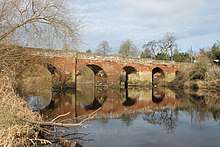Farndon Bridge
Farndon Bridge crosses the River Dee and the England-Wales border between the villages of Farndon, Cheshire, England and Holt, Wales (grid reference SJ412544). The medieval bridge, which was built in the mid 14th century, is recorded in the National Heritage List for England as a designated Grade I listed building[1] and is a scheduled monument.[2][3] It is built from locally quarried red sandstone and had eight arches, of which five are over the river. On the Farndon side there is one flood arch and two flood arches are on the Holt side.[1]

Farndon Bridge | |
|---|---|
 Farndon Bridge | |
| Coordinates | 53.083373°N 2.879820°W |
| Crosses | River Dee |
| Locale | Farndon, Cheshire, England and Holt, Wales |
| Heritage status | Grade I listed |
| Characteristics | |
| Design | Arch bridge |
| History | |
| Opened | 1339 |
| Statistics | |
| Toll | None (Abolished 1866) |

| |
Documentary evidence states the bridge was built in 1339 by St Werburgh's Abbey in Chester. Originally it had ten arches with a large gate tower on the fifth arch (from the English side). The tower was demolished down to road level in 1770 and at some time two of the arches on the Welsh side were lost.[4] The area is reputedly haunted by two sons of a Welsh Prince who were drowned in the river at this point by their English guardians, John de Warenne, 6th Earl of Surrey and Roger Mortimer de Chirk.[5]
During the English Civil war, a brief skirmish occurred near the bridge in 1643 when Parliamentarian forces advanced towards the Royalists holding Holt on the western side of the river.[6]
John Warwick Smith (26 July 1749 – 22 March 1831), a British watercolour landscape painter and illustrator, produced a fine painting of the bridge and the landscape around. It has been reproduced since for use on postcards.
Access is controlled by traffic lights, permitting road traffic to cross using the single-lane carriageway. Two narrow footpaths on either side of the road are provided for pedestrians. However, due to the bridge's age, it is closed intermittently for surveys to be conducted on its structure. In the early 1990s the bridge was restored and renovated and at the same time an archaeological survey was carried out.[7] In the summer of 2018 the bridge was closed for significant structural repairs.[8]
See also
- Grade I listed buildings in Cheshire West and Chester
- Grade I listed buildings in Wrexham
- Listed buildings in Farndon, Cheshire
References
- Historic England, "Farndon Bridge (1279428)", National Heritage List for England, retrieved 1 August 2012
- Pastscape: Farndon Bridge, English Heritage, archived from the original on 15 July 2012, retrieved 29 March 2008
- Historic England, "Farndon Bridge (1006758)", National Heritage List for England, retrieved 1 August 2012
- Ward, S. S, "A Survey of Holt-Farndon Medieval Bridge", Cheshire Past, Chester Archaeological Service, pp. 14–15, retrieved 29 March 2008
- Holland, Richard (30 July 2009). "BBC – North East Wales – Wrexham's Bridge of Screams". BBC. Retrieved 24 August 2014.
- "CHESHIRE HISTORIC TOWNS SURVEY: Farndon Archaeological Assessment" (PDF). /www.cheshirearchaeology.org.uk. Retrieved 14 June 2018.
An account of the Battle of Farndon Bridge, a Civil War skirmish that took place in 1643, states that the Parliamentary side ‘...advanced that night to Farne, which is a little towne on the Cheshire side – over against the Holt in Wales where the enemy kept a garrison’ (Latham ed. 1981, 27). The east window of St Chad’s Church contains 17th century glass depicting Royalist figures (CSMR 1791/1/1). "
- Royden, Mike, "Farndon-Holt Bridge", Farndon Local History, Mike Royden, retrieved 29 March 2008
- "Farndon Bridge to close for major repair work". Chester Chronicle. 22 May 2018.